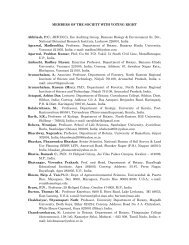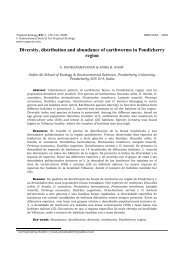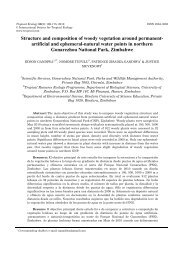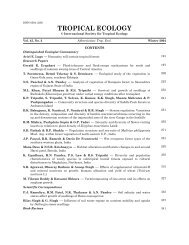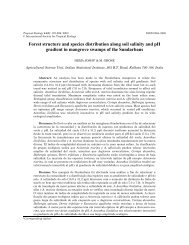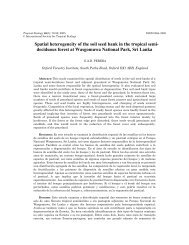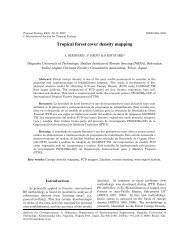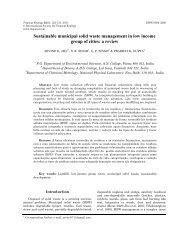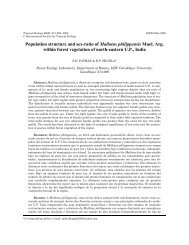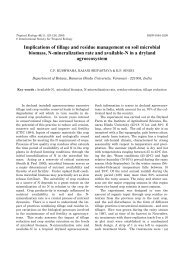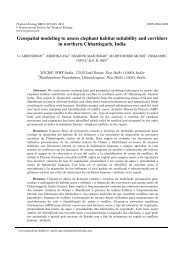Variation in seed and seedling characters of Jatropha curcas L. with ...
Variation in seed and seedling characters of Jatropha curcas L. with ...
Variation in seed and seedling characters of Jatropha curcas L. with ...
You also want an ePaper? Increase the reach of your titles
YUMPU automatically turns print PDFs into web optimized ePapers that Google loves.
GHOSH & SINGH 121<br />
by select<strong>in</strong>g large <strong>and</strong> heavy <strong>seed</strong>s. The performance<br />
<strong>of</strong> <strong>seed</strong> immediately after germ<strong>in</strong>ation<br />
is governed by <strong>seed</strong> size (Willan 1985). Heavy <strong>and</strong><br />
large <strong>seed</strong>s conta<strong>in</strong> more food reserves than<br />
smaller ones, which is helpful <strong>in</strong> germ<strong>in</strong>ation by<br />
provid<strong>in</strong>g more energy (Lusk 1995). Similar f<strong>in</strong>d<strong>in</strong>gs<br />
were also reported by Ponnamal et al. (1993).<br />
For example, <strong>with</strong><strong>in</strong> the zone humid western<br />
Himalayan region, <strong>seed</strong>s from PJSet-1 had maximum<br />
<strong>seed</strong> weight <strong>and</strong> the highest germ<strong>in</strong>ation<br />
percent.<br />
Seed size <strong>and</strong> weight are two important<br />
<strong>characters</strong> for improv<strong>in</strong>g <strong>seed</strong>l<strong>in</strong>g productivity <strong>and</strong><br />
reduc<strong>in</strong>g nursery cost through selection <strong>of</strong> quality<br />
<strong>seed</strong>s, apart from select<strong>in</strong>g <strong>and</strong> del<strong>in</strong>eat<strong>in</strong>g provenances<br />
(Armstrong & Westoby 1993; Isik 1986;<br />
Uniyal et al. 2002). The purpose for provenance<br />
test<strong>in</strong>g is to measure the pattern <strong>of</strong> genetic variation<br />
<strong>and</strong> to aid <strong>in</strong> selection <strong>of</strong> well-adapted <strong>and</strong><br />
highly productive <strong>seed</strong> sources for silvicultural<br />
practices.<br />
With<strong>in</strong> the zone sub-humid to humid eastern<br />
<strong>and</strong> south eastern upl<strong>and</strong>s <strong>and</strong> arid western pla<strong>in</strong>,<br />
highest <strong>seed</strong> weight was observed for Danikundi<br />
<strong>and</strong> Bawal provenances respectively, at the same<br />
time both provenances produced highest <strong>seed</strong>l<strong>in</strong>g<br />
length <strong>in</strong> their respective zones. Hence, it is clear<br />
that <strong>seed</strong>s <strong>with</strong> greater <strong>seed</strong> weight produced<br />
<strong>seed</strong>l<strong>in</strong>gs <strong>with</strong> higher shoot length. This may be<br />
due to greater nutrient reserves <strong>in</strong> larger <strong>seed</strong>s<br />
(Kathju et al. 1978). Similar trend was also<br />
reported for Virola koschyni (Gonzales 1993),<br />
Hardwickia b<strong>in</strong>ata (Ponnamal et al. 1993) <strong>and</strong><br />
Albizia lebbek (Roy 1985). Thus it can be concluded<br />
that <strong>seed</strong> size has operational importance.<br />
Provenances <strong>with</strong> higher <strong>seed</strong> weight also<br />
possessed higher length <strong>and</strong> vice versa. Provenances<br />
PJ Set-1, <strong>with</strong><strong>in</strong> humid western Himalayan<br />
region, Bawal, <strong>with</strong><strong>in</strong> arid western pla<strong>in</strong>, Danikundi,<br />
<strong>with</strong><strong>in</strong> sub-humid to humid eastern <strong>and</strong><br />
south eastern upl<strong>and</strong>s, NRCAF-13, <strong>with</strong><strong>in</strong> subhumid<br />
Sutlej Ganga alluvial pla<strong>in</strong>, Na<strong>in</strong>pur,<br />
<strong>with</strong><strong>in</strong> semi-arid lava plateaus <strong>and</strong> central highl<strong>and</strong>s<br />
<strong>and</strong> TNMC-3, <strong>with</strong><strong>in</strong> humid to semi-arid<br />
Western Ghats <strong>and</strong> Karnataka plateaus, had the<br />
highest <strong>seed</strong> length along <strong>with</strong> highest <strong>seed</strong><br />
weight. Similar results were also reported <strong>in</strong><br />
Albizia lebbeck (Bhat & Chauhan 2002; Luna et al.<br />
2006). Seed weight is also related to oil content.<br />
Zones <strong>with</strong> higher <strong>seed</strong> weight also had higher oil<br />
per cent.<br />
The significant difference <strong>in</strong> various <strong>seed</strong> morphological<br />
<strong>and</strong> <strong>seed</strong>l<strong>in</strong>g <strong>characters</strong> <strong>of</strong> J. <strong>curcas</strong><br />
provenances is <strong>in</strong>dicative <strong>of</strong> the possibility <strong>of</strong> select<strong>in</strong>g<br />
large <strong>and</strong> heavier <strong>seed</strong>s for further improvement<br />
work. Significant zonal impact revealed that<br />
environmental factors contribute <strong>in</strong> chang<strong>in</strong>g external<br />
appearance as the species grows <strong>in</strong> a wide<br />
range <strong>of</strong> ecological conditions <strong>and</strong> hence population<br />
can be expected to experience markedly selective<br />
pressure on <strong>seed</strong> <strong>characters</strong>. The zonal <strong>and</strong><br />
provenance variation could partly arise from<br />
genetic diversity which needs to be studied <strong>in</strong><br />
detail.<br />
Acknowledgements<br />
Authors are thankful to the authorities <strong>of</strong><br />
Indira G<strong>and</strong>hi Krishi Vishwavidyalaya, Raipur,<br />
India, for provid<strong>in</strong>g necessary assistance. F<strong>in</strong>ancial<br />
support was provided by National Oil<strong>seed</strong>s <strong>and</strong><br />
Vegetable Oils Development Board (M<strong>in</strong>istry <strong>of</strong><br />
Agriculture, Government <strong>of</strong> India), Gurgaon, India.<br />
References<br />
Armstrong, D. P. & M. Westoby. 1993. Seedl<strong>in</strong>g from<br />
large <strong>seed</strong>s tolerate defoliation better. A test us<strong>in</strong>g<br />
phylogenetically <strong>in</strong>dependent contrasts. Ecology 74:<br />
1090-1100.<br />
Banerji, R., A. R. Chowdhury, G. Mishra, G. Sudarsanam,<br />
S.C. Verma & G. S. Shrivastava. 1985. <strong>Jatropha</strong><br />
<strong>curcas</strong> <strong>seed</strong> oils for energy. Biomass 8: 277-<br />
282.<br />
Bhat, G. S. & P. S. Chauhan. 2002. Provenance variation<br />
<strong>in</strong> <strong>seed</strong> <strong>and</strong> <strong>seed</strong>l<strong>in</strong>g traits <strong>of</strong> Albizia lebbeck Benth.<br />
Journal <strong>of</strong> Tree Sciences 21: 52-57.<br />
Burley, J. & D. G. Nikles (eds.). 1973. Tropical Provenance<br />
<strong>and</strong> Progeny Research <strong>and</strong> International<br />
Cooperation. Commonwealth Forestry Institute,<br />
Oxford, Engl<strong>and</strong>.<br />
Forson, F. K. 2004. Performance <strong>of</strong> <strong>Jatropha</strong> oil blends<br />
<strong>in</strong> a diesel eng<strong>in</strong>e. Renewable Energy 29:1135-1145.<br />
Gonzales, J. F. 1993. Effect <strong>of</strong> <strong>seed</strong> size on germ<strong>in</strong>ation<br />
<strong>and</strong> <strong>seed</strong>l<strong>in</strong>g vigor <strong>of</strong> Virola koschyni Warb. Forest<br />
Ecology <strong>and</strong> Management 57: 275-281.<br />
Gubitz, G. M., M. Mittelbach & M. Trabi. 1999. Exploitation<br />
<strong>of</strong> the tropical <strong>seed</strong> plant <strong>Jatropha</strong> <strong>curcas</strong> L.<br />
Bioresources Technology 67:73-82.<br />
Isik, K. 1986. Altitud<strong>in</strong>al variation <strong>in</strong> P<strong>in</strong>us brutia: Seed<br />
<strong>and</strong> <strong>seed</strong>l<strong>in</strong>g characteristics. Silvae Genetica 35: 58-<br />
67.<br />
Kathju, S., A. N. Lahiri & K. A. Shankarnarayan. 1978.<br />
Influence <strong>of</strong> <strong>seed</strong> size <strong>and</strong> composition on dry matter<br />
yield <strong>of</strong> Cenchrus ciliaris. Experientia 34: 848-849.<br />
Keith, O. 2000. A review <strong>of</strong> <strong>Jatropha</strong> <strong>curcas</strong>: an oil plant<br />
<strong>of</strong> unfulfilled promise. Biomass <strong>and</strong> Bioenergy 19:1-<br />
15.





